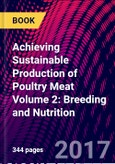Audience: Academic researchers in poultry science; Government agencies responsible for food safety/quality and poultry farming; Poultry and egg processors
Table of Contents
Part 1 Genetics and breeding1. Genes associated with functional traits in poultry: implications for sustainable genetic improvement: Samuel E. Aggrey, University of Georgia, USA; Fernando González-Cerón, Chapingo Autonomous University, Mexico; and Romdhane Rekaya, University of Georgia, USA
2. A balanced approach to commercial poultry breeding: Nicholas B. Anthony, University of Arkansas, USA
3. Marker-assisted selection in poultry: P. M. Hocking and J. Hickey, University of Edinburgh, UK Part 2 Animal nutrition
4. The cellular basis of feed efficiency in poultry muscle: mitochondria and nucleic acid metabolism: Walter Bottje and Byung-Whi Kong, University of Arkansas, USA
5. Understanding feed and water intake in poultry: Sami Dridi, University of Arkansas, USA
6. Advances and future directions in poultry feeding:an overview: Velmurugu Ravindran and Mohammad R. Abdollahi, Massey University, New Zealand
7. Advances in understanding and improving the role of amino acids in poultry nutrition: William A. Dozier, III, Auburn University, USA and Paul B. Tillman, Poultry Technical Nutrition Services, Georgia, USA
8. Advances in understanding and improving the role of enzymes in poultry nutrition: Bogdan A. Slominski, University of Manitoba, Canada
9. Advances in understanding the role of phytate in phosphorus and calcium nutrition of poultry: Markus Rodehutscord, University of Hohenheim, Germany
10. Probiotics, prebiotics and other feed additives to improve gut function and immunity in poultry: Robert Moore, RMIT University, Australia
11. Using models to optimise poultry nutrition: R. M. Gous and C. Fisher, University of KwaZulu-Natal and EFG Software, South Africa
12. Developments in feed technology to improve poultry nutrition: Charles Stark, Kansas State University, USA; and Adam Fahrenholz, North Carolina State University, USA
13. Alternative sources of protein for poultry nutrition: Paul A. Iji, Mehdi Toghyani, Emmanuel U. Ahiwe and Apeh A. Omede, University of New England, Australia
14. Maintaining the safety of poultry feed: G. Raj Murugesan and Chasity M. Pender, BIOMIN America Inc., USA
15. Thermal adaptation and tolerance of poultry: Shlomo Yahav, Institute of Animal Science, ARO, Israel








